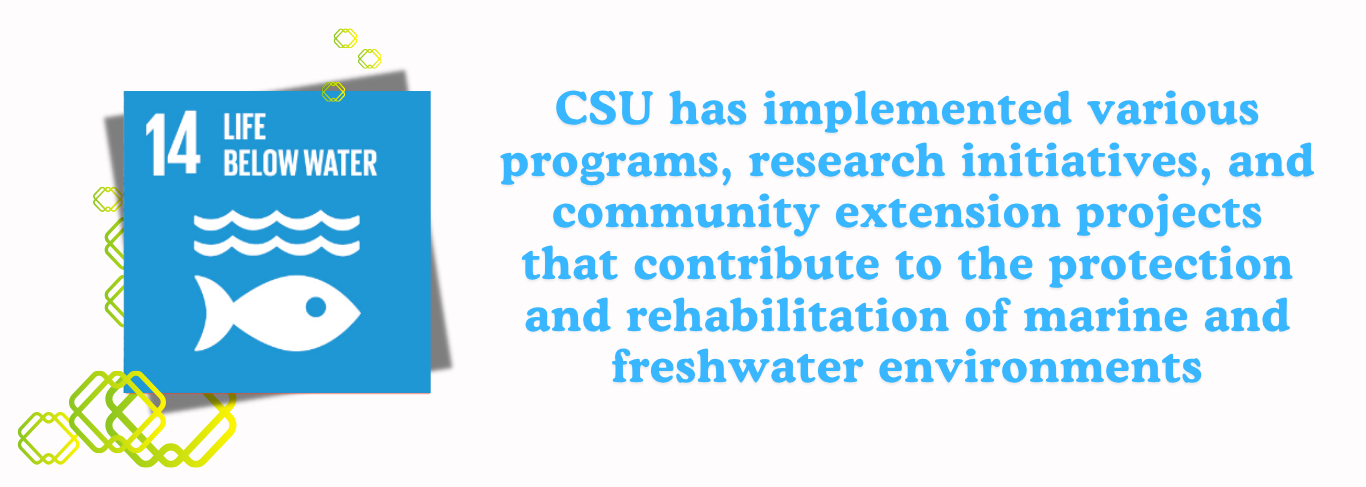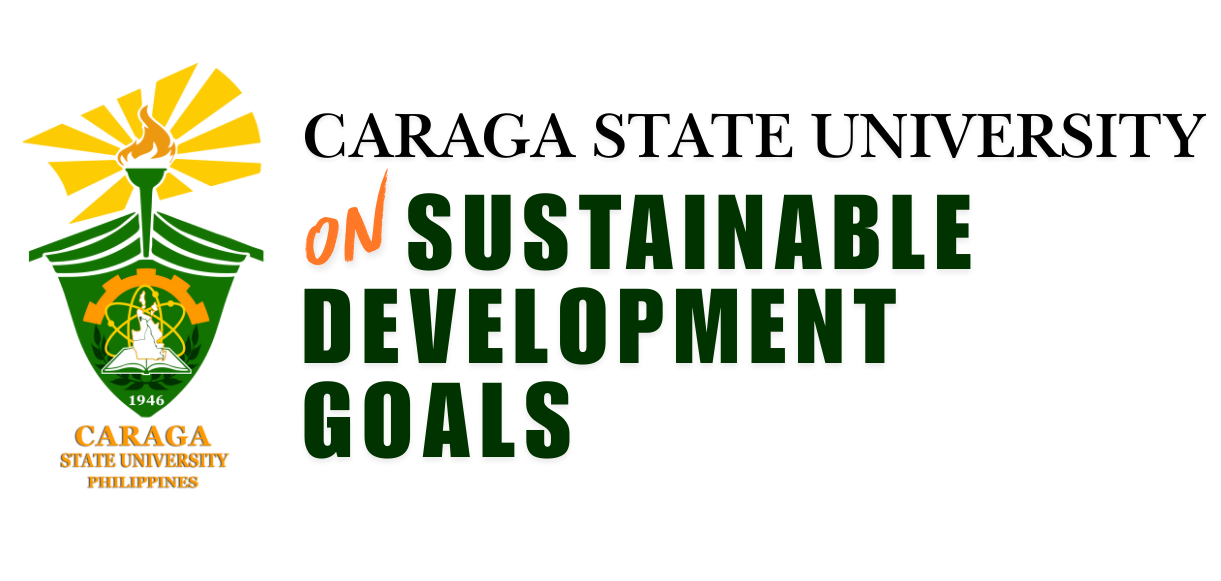Sustainable Development Goal (SDG) 14: Life Below Water

I. Introduction
Caraga State University (CSU) aligns its institutional mandates with the United Nations Sustainable Development Goals (SDGs), particularly SDG 14 Life Below Water, which seeks to conserve and sustainably use the oceans, seas, and marine resources for sustainable development. The role of the aquatic ecosystems are important in supporting local livelihoods and maintaining ecological balance. CSU has implemented various programs, research initiatives, and community extension projects that contribute to the protection and rehabilitation of marine and freshwater environments.
Through collaborative efforts with government agencies, local communities, and partner institutions, CSU aims to address key indicators under SDG 14 such as reducing marine pollution, restoring aquatic ecosystems, promoting sustainable fisheries, and enhancing education and awareness on aquatic ecosystem conservation.
This report, presents a comprehensive overview of CSU’s initiatives, outcomes, and contributions across all sub-targets of SDG 14. It highlights the university’s continuing efforts to serve as a catalyst for the conservation and sustainable use of aquatic resources in Caraga Region. These initiatives reflect the University’s dedication to environmental stewardship and its mission to generate science-based solutions for the sustainable management of the region’s aquatic resources.
14.2 Supporting aquatic ecosystems through education
Caraga State University actively supports the conservation and sustainable management of aquatic ecosystems through its academic programs that integrate environmental education and stewardship. The Bachelor of Science in Biology Program offers a Freshwater Conservation and Management course, which provides students with a deep understanding of freshwater ecosystems, their ecological importance, and the challenges they face due to human activities and climate change. This course equips future biologists with the knowledge and skills to design and implement strategies for the protection and restoration of inland water bodies such as rivers, lakes, and wetlands.
Similarly, the Bachelor of Science in Environmental Science program strengthens aquatic ecosystem education through courses like Watershed Management and Aquatic Resource Management. These courses focus on the interconnection between terrestrial and aquatic systems, emphasizing sustainable watershed practices, water quality monitoring, and resource management approaches that promote ecological balance and biodiversity conservation.
Through these specialized courses, students gain not only theoretical knowledge but also practical field experience in assessing and managing aquatic environments. This educational approach ensures that graduates are well-prepared to contribute to local and regional efforts in protecting freshwater and marine ecosystems—aligning with the goals of SDG 14: Life Below Water and advancing CSU’s mission of fostering environmental sustainability through education and research.
14.3 Supporting aquatic ecosystems through action
Caraga State University (CSU) continues to strengthen its commitment to SDG 14: Life Below Water by undertaking concrete actions that promote the conservation, sustainable use, and restoration of aquatic ecosystems. Through academic, research, and community-based initiatives, the university has actively contributed to the protection of marine and freshwater resources across the Caraga Region.
One of the significant initiatives under this indicator is the International Forum on Sustainability Science (IFSS), which serves as a platform for knowledge exchange and advocacy on environmental protection, sustainable resource management, and aquatic ecosystem conservation. This annual event brings together researchers, faculty members, students, and partner institutions to discuss innovative approaches and collaborative strategies in addressing environmental challenges affecting ecosystems including oceans, rivers, and lakes.
In addition, CSU has conducted a Mangrove Rehabilitation awareness seminar in partnership with Barangay Local Government Unit of Pagatpatan in Butuan City. The activity raises awareness on the critical role of mangroves in protecting shorelines, supporting marine biodiversity, and mitigating the impacts of climate change. Through these on-ground efforts, CSU demonstrates its dedication to sustaining marine and coastal ecosystems and ensuring their long-term ecological balance.
Furthermore, the university has strengthened its research engagements through international collaboration. The Ceremonial Signing of the Collaborative Research Agreement between Caraga State University and Hokkaido University (Japan) marked a milestone partnership in marine biodiversity research. This collaboration focuses on marine invertebrate systematics and taxonomy. Also, an impact assessment of the Cabadbaran Fish Sanctuary was conducted by some faculty in CSU contributing to the scientific understanding and management of marine ecosystems under threat.
14.4 Water sensitive waste disposal
Caraga State University (CSU) is implementing policies and initiatives aimed at preventing and reducing marine pollution, particularly those originating from land-based activities. Recognizing that improper waste management and pollution from inland areas significantly affect downstream aquatic and marine ecosystems, the university has established measures to promote environmental responsibility within its campus and surrounding communities.
In 2017, CSU formally adopted an Eco-Friendly University Policy, which highlights the institution’s dedication to environmental sustainability and pollution prevention. The policy promotes responsible consumption and waste reduction by mandating that take-out orders be served only in non-disposable containers provided by the buyer, allowing only glass-bottled beverages to be sold within the campus, and prohibiting the use of plastic straws. It also reinforces the principle of personal accountability through a “bring your own garbage and dispose of it properly” guideline. These measures collectively aim to minimize single-use plastic waste, reduce pollution from land-based sources, and cultivate a culture of environmental discipline among the CSU community. While the policy has been effective in nurturing a culture of environmental awareness, CSU acknowledges the need to reinforce and update it to address emerging environmental challenges brought about by rapid technological changes, population growth, and evolving waste management concerns.
To strengthen policy implementation, CSU has undertaken regular monitoring of proper waste segregation inside the campus. This ongoing effort ensures that biodegradable, non-biodegradable, recyclable, and hazardous wastes are properly managed and disposed of. This prevents waste from entering waterways that eventually lead to marine environments. These monitoring activities are conducted in coordination with campus offices and student organizations to sustain a clean, safe, and ecologically responsible academic environment.
Through its eco-friendly policies and continued monitoring initiatives, Caraga State University not only minimizes its ecological footprint but also contributes to the broader regional effort to reduce land-based sources of marine pollution.
14.5 Maintaining a local ecosystem
Caraga State University (CSU) continues to demonstrate its commitment to SDG 14: Life Below Water by actively engaging in partnerships that promote the protection and rehabilitation of local aquatic ecosystems. Recognizing the importance of collaboration in maintaining clean and healthy waterways, CSU has established a Memorandum of Agreement (MOA) with the Environmental Management Bureau (EMB)–DENR Caraga and the Barangay Local Government Unit (BLGU) of Ampayon for the Adopt-an-Estero Extension Project.
The Adopt-an-Estero initiative is an environmental program that aims to restore and sustain the ecological health of Ampayon creek through shared responsibility and collective action. Under this partnership, CSU provides technical support, conducts research, engages students and faculty in cleanup drives, and community education campaigns. The EMB–DENR conducts regular monitoring of the estero’s water quality, while the BLGU Ampayon serves as a key partner in providing policy support, logistical coordination, and ensuring the long-term sustainability of the project.
Through this collaboration, CSU not only contributes to the physical rehabilitation of the adopted creek (estero) but also strengthens community awareness and participation in environmental protection. The initiative exemplifies the university’s role as a catalyst for environmental stewardship which links academic knowledge, research, and civic engagement to maintain and enhance shared aquatic ecosystems.

